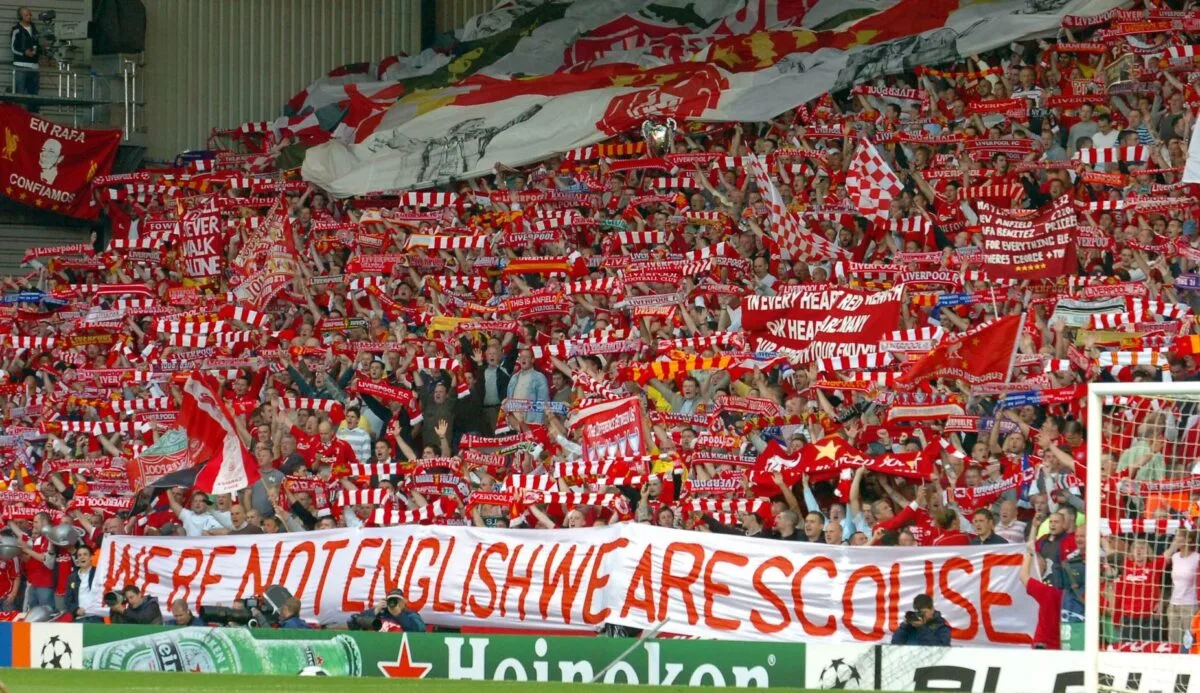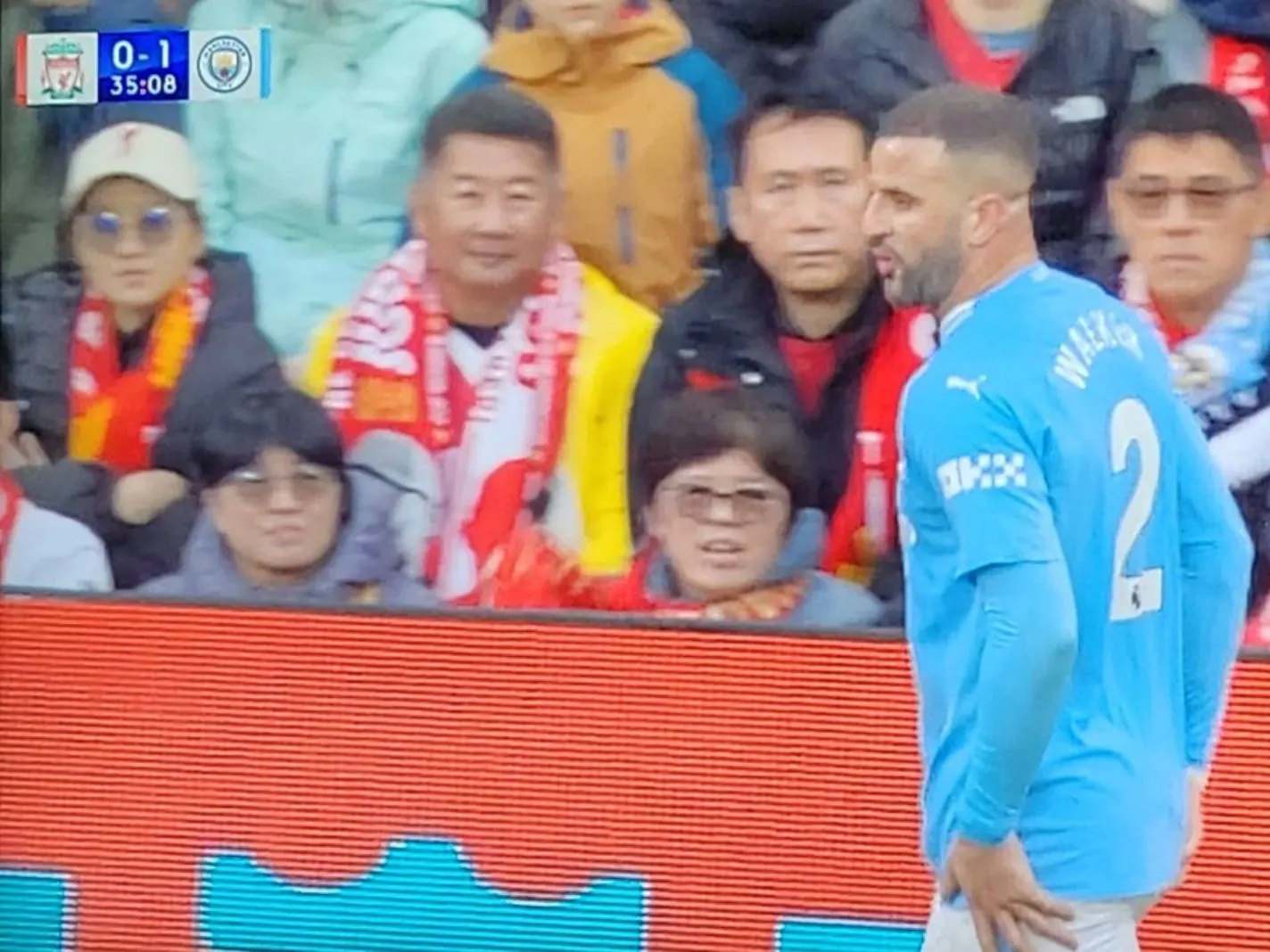Liverpool has been flying high this season. With 64 points in 28 matches, they are tied as leaders of the Premier League table alongside Arsenal. Their impressive performance is particularly noteworthy considering the absence of key players due to injuries. The team’s resilience was evident in their recent drawn game against the formidable Manchester City, where they faced the challenge with a fairly young and depleted squad, a testament to Klopp’s managerial prowess and Liverpool’s unwavering determination.
However, no matter how strong Liverpool can be on the pitch, the scenes from the home stands of Anfield does not always present an equally rosy picture.
There have been several instances of rebellious sentiments emerging in the Anfield home stand, showcasing defiant expressions. One frequently seen banner boldly states “We are not English, We are Scouse” or “Anfield is not in England.” Additionally, there have been occurrences of jeering and protest whistling when the England national anthem is played before matches.
That said, a discussion recently arose on social media regarding a tweet that featured a photo of the Anfield stand during the Manchester Derby, showing rows of Chinese supporters in the home stand wearing the red Liverpool shirt. Interestingly, the caption of the tweet read, “Scouse not English.”
Despite some tagging the tweet as potentially racist, the association of Chinese heritage with a Merseyside club surprised many. However, exploring the history of Liverpool city reveals an intriguing backstory.
The Chinese Community in Liverpool
Liverpool is renowned for hosting the oldest established Chinese community in Europe. This community’s roots trace back to 1834 when trade connections began to flourish between China and Britain through the ports of Shanghai and Liverpool.
The initial wave of Chinese immigrants arrived in Liverpool in 1866 coinciding with the establishment of the Blue Funnel Shipping Line, a branch of the Holt Ocean Shipping Company. This line operated steamers directly between Liverpool and China. These trade connections played a crucial role in fostering the growth of a Chinese community within the city. Many immigrants settled in an area near the docks, particularly in Cleveland Square.
The Holt Shipping Company provided boarding houses to accommodate its workers. By the start of World War II, Liverpool was home to as many as 20,000 Chinese mariners. It was in this area, along with the surrounding streets, that the first Chinese settlers established businesses to provide services to their fellow countrymen.
By the 1890s, Chinese entrepreneurs began setting up shops, cafes, and boarding houses to meet the needs of the expanding community. According to the International Organization for Migration (IOM), the Chinese population in Liverpool is estimated to range from 25,000 to 35,000 as per a census report in 2009.
Interestingly, in 2015, The Liverpool China Partnership (LCP) was formed to expand, strengthen, and deliver greater benefit from the Liverpool City Region and Isle of Man’s trade, investment, tourism, education, cultural, civic, and other links with China.
Almost two centuries later, Liverpool is now home to the oldest Chinese community in Europe, and some people identify as Scousers despite being Chinese. For those unaware, ‘Scouser’ is a British term for someone who is from or lives in Liverpool, England. Having lived in the city for generations, they have adopted the local identity as their own, even though they are from a different heritage altogether. As a matter of fact, many of these Chinese descendants are season ticket holders for the club in red.
Indeed, while it may initially seem surprising to see Asian faces in the Anfield stands, their presence, especially during a high-profile Manchester Derby, makes perfect sense given Liverpool’s rich historical ties with the Chinese community.
But why the caption- ‘Scouse not English’?

This tagline or sometime even booing of the anthem song might come across as disrespectful, but it’s deeply intertwined with the history and culture of Liverpool, particularly its immigrant communities. It perhaps best epitomizes the struggles that Liverpool natives feel in regard to patriotism and nationalism.
It must be noted that not only Chinese, but Liverpool has a significant population with Irish heritage as well. During the years of famine in Ireland, around 1.5 million people passed through the Port of Liverpool in search of refuge and opportunity. Census returns from the time show the Irish-born population in Liverpool, boosted by Famine migration, rose from 17.3% of the total population in 1841 to 22.3% in 1851.
Jon Tonge, a Professor of British and Irish Politics at the University of Liverpool, commented on this immigration stating: ‘The sheer scale of immigration into Liverpool from Ireland made Liverpool distinctive. There was a huge amount of Irish immigration in other places too, but Liverpool was off the scale.”.
And looking back at the statement now, there is no denying that this off-scale immigration became the primary reason for the general dissent that gradually became the agenda of political issues that have now escalated to what it is now.
A significant portion of Liverpudlians’ sense of being marginalized on English soil stems from the historical treatment by Conservative-led governments spanning several decades. With a perceived lack of support from their government, individuals from Liverpool tend to identify less as English and more as their distinct ‘Scouse’ entity. Liverpool has always viewed itself as unique, separate from the rest of England — influenced by its Irish heritage and embracing an international outlook.
This sentiment was particularly pronounced in the 1980s under the leadership of Conservative Prime Minister Margaret Thatcher, as she and her party appeared indifferent to the “managed decline” of Merseyside. Thatcher’s implementation of monetarist policies from 1979 to 1984 resulted in the loss of over half of Merseyside’s manufacturing jobs, leading to significant social unrest and hardship in the city. The city experienced severe unemployment and poverty during this period. The government’s reluctance to provide assistance, coupled with cuts to public services, exacerbated the challenges faced by Liverpool and its residents.
The Conservative government’s policy of ‘managed decline’ for the city was followed by the government’s mishandling of the Hillsborough disaster, which further entrenched the feelings of neglect and resentment among population.
“In plain English, that meant withdrawing resources from the region so that residents would be forced to leave,” states the Independent. “Effectively starving them out.”
This led to a feeling of solidarity among the residents of the city, feeling left out that their region did not have the backing of the government, and that it was never a priority. Liverpool as a city has changed dramatically since the 1980s. However, the underlying feelings of disregard and resentment towards a government that never fully supported them persist among its citizens. As a result, they tend to distance themselves from the tag of being “Englishmen” and consider themselves as “Scousers”.
“The magic of Liverpool is that it isn’t England,” remarked Margaret Simey in 1999, the former Granby councillor.
Sure, these kinds of political and governmental agendas are not quite uncommon, and this will not be the last time we will be seeing those banners in Anfield stands. But with Jurgen Klopp’s managerial tenure with the club nearing its end and Liverpool’s remarkable performance on the field, it just makes more sense to set aside such agendas and simply savor the game.


Leave a comment
You must be logged in to post a comment.